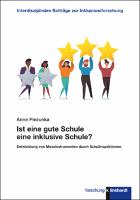Ist eine gute Schule eine inklusive Schule?
Entwicklung von Messinstrumenten durch Schulinspektionen
Abstract
Due to the UN Convention on the Rights of Persons with disabilities, the Federal States of Germany have to implement inclusive education. However, there is no shared understanding how to define inclusive education in Germany. Therefore, different understandings on how to implement inclusive education within the schools exist. Comparing different Federal States of Germany, Anne Piezunka examines how school inspectorates define inclusive education. School inspectorates are part of the educational administration. They evaluate the quality of schools and are a key means of accountability. Evaluating the quality of schools, they analyze documents, conduct interviews and observe classes. Thereby, they apply several metrics. For example: “The class starts on time”. Every federal state has developed its own metrics. Piezunka analyzes which metrics school inspectorates apply to evaluate the implementation of inclusive education on the school level. Interviewing the developers of metrics, she also studies the development of these metrics and seeks to explain differences between the federal states. The study brings together sensemaking theory, sociology of evaluation and research on inclusive education. (DIPF/Orig.) Die Umsetzung von schulischer Inklusion findet in Deutschland auf verschiedenen Ebenen des Bildungssystems statt, z.B. in der Gestaltung der Schulstruktur. In diesem Zusammenhang stellt sich die Frage, wie sich die Umsetzung von Inklusion abbilden lässt. In Abhängigkeit davon, wie Inklusion als politische Vorgabe gedeutet wird, kann es beispielsweise variieren, welche empirischen Daten hierfür erhoben werden. Daran anknüpfend geht es im Rahmen der Arbeit um die Fragen, inwiefern Inklusion in den Messinstrumenten der Schulinspektion berücksichtigt wird und wie diese entstanden sind. Schulinspektionen evaluieren in den einzelnen Bundesländern mithilfe von Messinstrumenten, z.B. Schülerfragebögen und Unterrichtsbeobachtungsbögen, die Qualität von Einzelschulen. Dabei unterscheiden sich die Bundesländer darin, welche Instrumente sie anwenden. Durch die Analyse der Messinstrumente und mithilfe von Experteninterviews wird herausgearbeitet, ob und welche Daten in Bezug auf die Umsetzung von Inklusion erhoben werden. Des Weiteren wird deutlich, wie die Messinstrumente der Schulinspektionen entstanden sind und welche Rahmenbedingungen prägend wirkten. Die Auseinandersetzung mit dem Entwicklungsprozess ermöglicht es zu zeigen, warum sich die Messinstrumente zwischen den Bundesländern unterscheiden. Für die Bearbeitung der Fragestellung wird auf organisations- und bewertungssoziologische Arbeiten (z.B. Sensemaking Ansatz) zurückgegriffen sowie auf zentrale Konzepte der Inklusionsforschung und den Educational Governance-Ansatz. (DIPF/Orig.)
Keywords
Inklusion; Schulqualität; Schule; Integration; Schulinspektion; Messinstrument; Qualitätskontrolle; Bewertung; Bildungspolitik; Bildungsforschung; Qualitätssicherung; Schulentwicklung; Indikator; Interview; Deutschland; Inclusion; School; Inspection of schools; Measurement instrument; Quality control; Assessment; Judgement; Judgment; Educational policy; Educational research; Quality assurance; School development; Indicator; GermanyDOI
10.35468/5799ISBN
9783781523609, 9783781557994, 9783781523609Publisher
Verlag Julius KlinkhardtPublication date and place
Bad Heilbrunn, 2020Classification
Schools and pre-schools
Teaching of students with different educational needs


 Download
Download Web Shop
Web Shop